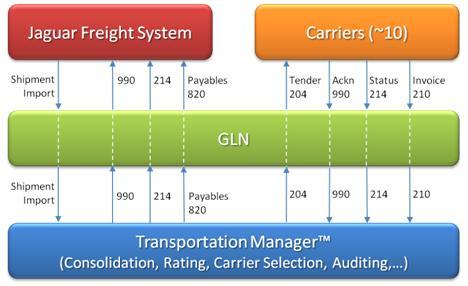Requirements for EDI to TMS
From UG
(→Examples) |
(→Examples) |
||
| Line 77: | Line 77: | ||
* '''Shipment Import''' | * '''Shipment Import''' | ||
| - | * 204 – Load tender message from Transportation Manager to the | + | * 204 – Load tender message from Transportation Manager to the carrier. A load tender is a request to pick up a shipment and move it to another location. |
| - | carrier. A load tender is a request to pick up a shipment and move it to | + | * 990 – '''Load Plan''' - The carrier’s tender response back to Transportation Manager (either a yes for picking up the shipment or no for not picking up the shipment). |
| - | another location. | + | * 214 – A '''Status message''' from the carrier to Transportation Manager (e.g., “Delivered”). |
| - | * 990 – '''Load Plan''' - The carrier’s tender response back to Transportation Manager | + | * 210 – An invoice from the carrier to Transportation Manager. The invoice will have the cost details of moving the shipment. |
| - | (either a yes for picking up the shipment or no for not picking up the | + | |
| - | shipment). | + | |
| - | * 214 – A '''Status message''' from the carrier to Transportation Manager | + | |
| - | (e.g., “Delivered”). | + | |
| - | * 210 – An invoice from the carrier to Transportation Manager. The | + | |
| - | invoice will have the cost details of moving the shipment. | + | |
== Integration points == | == Integration points == | ||
Revision as of 15:51, 18 October 2010
Contents |
About and See also
This is a Analysis / Requirements wiki for EDI to TMS proj
Related
See also: Data Dictionary for EDI to TMS
Glossary
IP - Integration Point
Tendering - Tendering is the process of offering a load to a carrier and efficiently managing their response.
NOTE: Descartes Transportation Manager enables you to communicate with your contracted carriers electronically or manually. You set the communication method for a carrier when you set up your carrier contracts.
See also: p 205 of TM+10.1.3+Users+Guide.pdf
Introduction
Core Business Need: Jaguar needs ability to optimize truck domestic shipments:
- create optimal loads and routs (About Loads and Shipments p151, Consolidation p173 , TM 10.1.3 Users Guide.pdf in mantis http://mantis.jaguarfreight.com/mantis/view.php?id=2183)
Above features are normally present in TMS software. In addition this kind of system can:
- automate tariffs (Working with Contracts chapter)
- communication with carriers
To achieve that it was decided:
- buy and use existing TMS solution (phase 1)
- gradually add these features to CT2 (phase 2)
To complete phase 1 we need to implement:
- #Vendor evaluation (completed)
- #CT2 and TMS integration - arrange data interchange
- #TMS User interaction and workflow - how CT2 (Client and Internal) will be used in conjunction with TMS
Vendor evaluation
Currently there are 2 systems we are considering:
- from Descartes
- from Lean Logistics
CT2 and TMS integration in a nutshell
In a nutshell:
- (shipment record will be created in CT2 and approved)
- IP1: Shipment Import New CT2 forwarded to TMS through EDI
- (in TMS Jag oper will run optimizations and select carrier)
- (TMS sens bids to carriers)
- IP2: Load Plan, code 990 TMS sends updates to CT2 (Carrier confirmed, etc)
- (start processing shipments)
- IP3: Status Message, code 214 TMS periodically submits updates into TMS (example: actual pickup date, etc)
See Figure below:
Figure Integration Points as defined by Descartes
Examples
Below are some examples of EDI messages used in Transportation Manager.
- Shipment Import
- 204 – Load tender message from Transportation Manager to the carrier. A load tender is a request to pick up a shipment and move it to another location.
- 990 – Load Plan - The carrier’s tender response back to Transportation Manager (either a yes for picking up the shipment or no for not picking up the shipment).
- 214 – A Status message from the carrier to Transportation Manager (e.g., “Delivered”).
- 210 – An invoice from the carrier to Transportation Manager. The invoice will have the cost details of moving the shipment.
Integration points
See following wikis:


